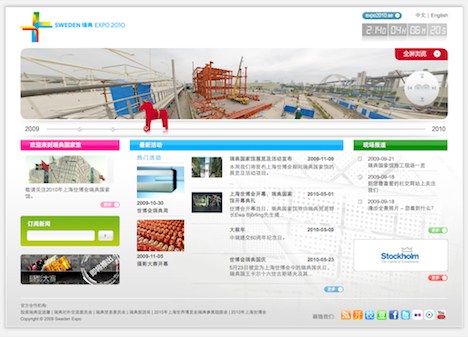It’s been quiet here on Ogle Earth (unless there is a neogeopolitical emergency to tend to) because the past month has been crunch time to get a new site out the door: The website of the Swedish Pavilion at Shanghai Expo 2010, or at least v1.0 of it, which launches today.

The site’s got lots of bright colors and the default page is in Chinese, because it is aimed shamelessly at the almost 400 million Chinese who have gone online, around 90% of whom have never been on an English language site. (Don’t worry, almost all of the site is also available in English.)
The website is not about neogeography, but it is very much about a specific place and time. I can justify plugging it here on Ogle Earth because it also comes with an interesting proof of concept about recreating a sense of place that perhaps one day we’ll see in Street View: A time-series of panoramas taken from the exact same location — in our case, right next to the Swedish pavilion, as it is being built. (Find it on the home page, and go straight for the full-screen view. Move the red Dalecarlian horse to and fro to see progress in the construction.)
Just as Google Earth’s satellite imagery became immensely more useful when the addition of historical imagery gave us the time dimension to play with, so too Street View would benefit when in a few years’ time multiple passes will have been made of the same roads. One challenge with such panoramas: Finding the exact same vantage point, so you can maintain the illusion of moving in time without moving perspective. That will likely not be easy to scale, considering that Street View cars can’t always choose their lane and that GPS is not that accurate.
But three years from now, I’d be surprised if we didn’t have viable 3D urban reconstructions from point clouds generated automatically out of successive Street Views. (Previously blogged proofs of concept include EarthMine and Photosynth.) In that kind of environment, the precise locations of panoramas in successive passes are no longer important, as the contents will all be mapped to a common evolving 3D surface anyway. Moving the time slider will let you see how the cityscape evolves, with both surface imagery and volumes progressing over time.
It’s something of a pity that such technology will arrive about a decade too late to document the immense pace of change here in Shanghai as neighborhoods are converted wholesale from row houses to skyscrapers.
But at least we’ve got the Swedish pavilion covered:-)
Related: I’ve previously written up my working notes on the different ways of marketing a place online (and the comments are worth reading too). I still need to implement many of these. One thing I think will be worth investigating is to see if it is possible to use the timeline feature Google Earth with a time-series of spherical panoramas as rendered in KML. But that’s a project for things get a little less crazy around here.
Unrelated but interesting: Notice how there is no way to comment on swedenexpo.cn? That’s because if you want a license to operate a website in China with user-generated content, you also have to hire a censor, and that is not politically possible for us (not to mention undesirable). We’ve found a solution, however — outsourcing the commenting (and censoring) to a slew of popular Chinese social networking sites. For those of you outside the Great Chinese Firewall (or with a VPN) There is the Facebook fan page and the Twitter feed.
Further examples: There are two other examples I’ve been made aware of where panoramas are linked together in a time series: A demo by Hans Nyberg and one of a spot on the Belgian coast. Any further examples are welcome.